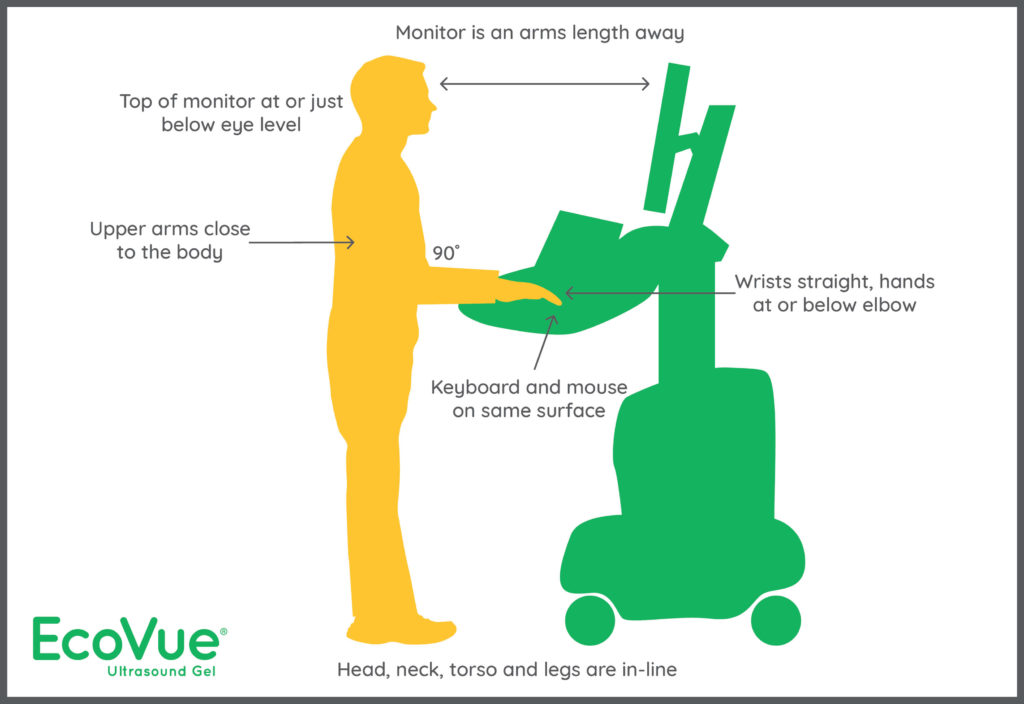The Sonographer’s Guide to Reducing Work-Related Injury: Ultrasound Ergonomics
Welcome back to our series on reducing work-related injuries! Sonography is a physically demanding job, with roughly two-thirds of sonographers reporting scanning while in pain according to a recent survey published in the Journal of Diagnostic Medical Sonography.
While many sonographers may be accustomed to scanning while in pain due to Work Related Musculoskeletal Disorders (WRMSDs), this shouldn’t be the case. We must work to improve basic ultrasound ergonomics in the workplace to help decrease pain and injury rates.
In today’s post, we’ll look at how sonographers can avoid work-related injury through modifications to scanning techniques, improving working posture, and basic ergonomics.
What is Ultrasound Ergonomics?
Ergonomics is the process of arranging your workspace to make your job more comfortable and productive while aiming to reduce the physical stress and resulting injuries associated with being a sonographer.
Risk Factors for WRMSDs
Early intervention is essential to preventing musculoskeletal pain and WRMSDs for sonographers. But before we can learn how to manage the issue, we must understand the growing number of physical risk factors that contribute to WRMSDs.
Excessive force or exertion
Sonographers often need to apply excessive force to the transducer while scanning to obtain quality images, especially with a growing number of patients with large body habitus. This exertion can cause pain and muscle fatigue.
Scanning tip: Hold the transducer lightly in a comfortable position while making sure your thumb and index finger are as relaxed as possible.
Awkward or sustained postures
As a sonographer, you often get into awkward positions while scanning a patient. When preparing for a new scan, always allow time to adjust the equipment to fit your needs, including arranging the keyboard or monitor, using a lightweight transducer, or carefully choosing the right equipment for mobile scans.
Scanning Tip: Ensure your wrist isn’t too flex or too extended while scanning. This can help reduce the risk for carpal tunnel.

Ideal Seated Position

Ideal Standing Position
Frequency or repetition
If you are constantly performing the same type(s) of exams, you may have an increased risk factor associated with repetition. Sonographers who are highly specialized, such as adult echo or MFM, are those most at risk for repetitive motions.
Scanning tip: Take a mini-break. Remove the transducer from your scanning hand and shake it out while stretching your arms and shoulders to get the blood flowing again.
Contact Pressure
You should avoid resting or leaning on objects, such as an exam table, while scanning. This is especially important for your wrists, forearm, and hips as you want to avoid creating contact pressure that pulls your spine out of alignment.
Scanning tip: Make sure your chair has an armrest, or use a wedge for arm support.
Sonographers have to take responsibility for their own health. In addition to basic ultrasound ergonomics, sonographers can practice daily stretching and exercise consistently while also practicing ambidextrous scanning to help avoid work-related injuries.
Ultrasound Ergonomics Takeaways to Reduce Risk of Injury:
- Take time to set up your equipment. Be mindful of monitor placement and how far away your patient is.
- Try to keep your arm as close to your side as possible, and don't forget about your grip.
- Standing while scanning might help if you struggle with posture.
- Take a mini-break and readjust if necessary.
It is important to remember that ergonomics is not a “one size fits all” approach. You should determine YOUR best practices and focus on things you can control. And remember…DON’T scan in pain.
If you are experiencing pain or discomfort while scanning, stop and reposition yourself while considering basic ergonomics, and check out this Sonographer’s Ergonomics Checklist.